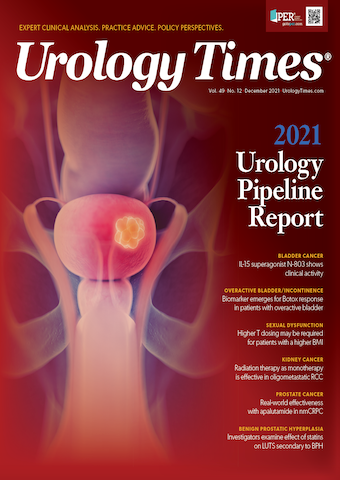Publication
Article
Urology Times Journal
Higher testosterone dosing may be required for patients with a higher BMI
Author(s):
In a recent study Martin M. Miner, MD, and co-authors investigated the effect of BMI on the pharmacokinetic profile or dosing of testosterone therapies in men with TD.
Martin M. Miner, MD

Individuals with a higher body mass index (BMI) are associated with a higher incidence of testosterone deficiency (TD); however, current dosing standards for testosterone therapy do not account for the possibility of obese patients (BMI ≥30 kg/m2) needing higher doses as a result of their high BMI.
In a recent study presented at the 2021 Sexual Medicine Society of North America Fall Scientific Meeting,1 Martin M. Miner, MD, and co-authors investigated the effect of BMI on the pharmacokinetic (PK) profile or dosing of testosterone therapies in men with TD. Miner is the founder of the Men’s Health Center at Miriam Hospital and clinical professor of family medicine and urology in the Warren Alpert School of Medicine at Brown University, Providence, Rhode Island.
Could you discuss the background for this study?
This study is a post-hoc analysis that I initiated. I was one of the original investigators of Xyosted in their phase 3 trial in pharmacokinetics. My question was, in men with a larger BMI, would they have data to support the use of a larger dose of their weekly testosterone injection? This is part of men receiving testosterone therapy for hypogonadism, or low testosterone levels associated with clinical signs and symptoms of testosterone deficiency. So, in this post-hoc analysis, we looked at the effect of body mass index on men receiving pharmacokinetic dosing of testosterone and the association between body mass index and serum total testosterone levels. The primary end point was the percentage of patients who received more than 1 dose of subcutaneous testosterone enanthate to achieve adequate serum testosterone levels over a 7-day dosing of the Xyosted. This included about 142 patients, and we looked at all of the pharmacokinetic parameters, including the trough levels, the area under the curve, the C average, and the C max.
What were some of the notable findings? Were any of them surprising to you and your co-authors?
What we found was that men who were classified in 3 tertiles based on body mass index had levels that were indeed low. And prior to achieving any dosage adjustments, men who were in the upper percentile in terms of body mass index required a larger dose of testosterone to achieve eugonadal levels, which means levels between 300 and 1100. The initial levels were inversely related to body mass index, so men who are the largest or had the largest BMI have the lowest testosterone levels. That's what you would expect with obese men., that the greater the amount of obesity, the lower their endogenous levels would be, and that men would require the largest dose adjustment if they had a larger BMI. In conclusion, we found that men who were larger or had larger BMIs would require larger dosing. It's an intuitive assumption that never has been found to be the case before.
How do these findings build on previous research into testosterone enanthate?
They supported the idea that for men who are obese, the greater the obesity, the lower their endogenous levels or baseline levels of testosterone. We know that there's an inverse relationship there and that the supposition or the premise that men who are larger would require larger amounts of testosterone to maintain normal or eugonadal levels.
What is the take-home message for the practicing urologist?
The take-home message is that when you're planning to begin repletion of testosterone, you're likely going to have to consider a man's body mass index and/or waist circumference in doing so. Also, that men who have a larger amount of visceral adiposity, or a larger body mass index, may require adjustments in dosing to achieve eugonadal levels and to achieve levels that replete and resolve their clinical symptomatology.
Is there anything else you feel our audience should know about the findings?
What's most important is that 1 dose does not just fit all, and that people really have to be individualized. Dosing for men, in terms of testosterone therapy, really needs to be repleted at an individual level.
Reference
1. Miner M, Amy T, Gollen R, et al. Subcutaneous testosterone enanthate and the effect of body mass index on serum testosterone in men with testosterone deficiency. Paper presented at: 2021 Sexual Medicine Society of North America Fall Scientific Meeting; October 21-24, 2021; Scottsdale, Arizona. Abstract #002

Newsletter
Stay current with the latest urology news and practice-changing insights — sign up now for the essential updates every urologist needs.































